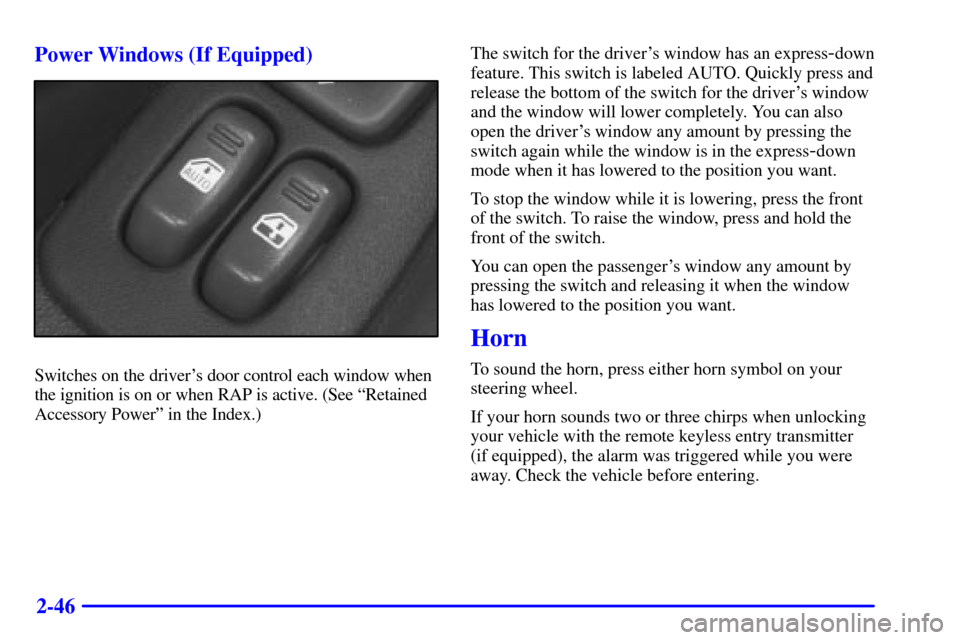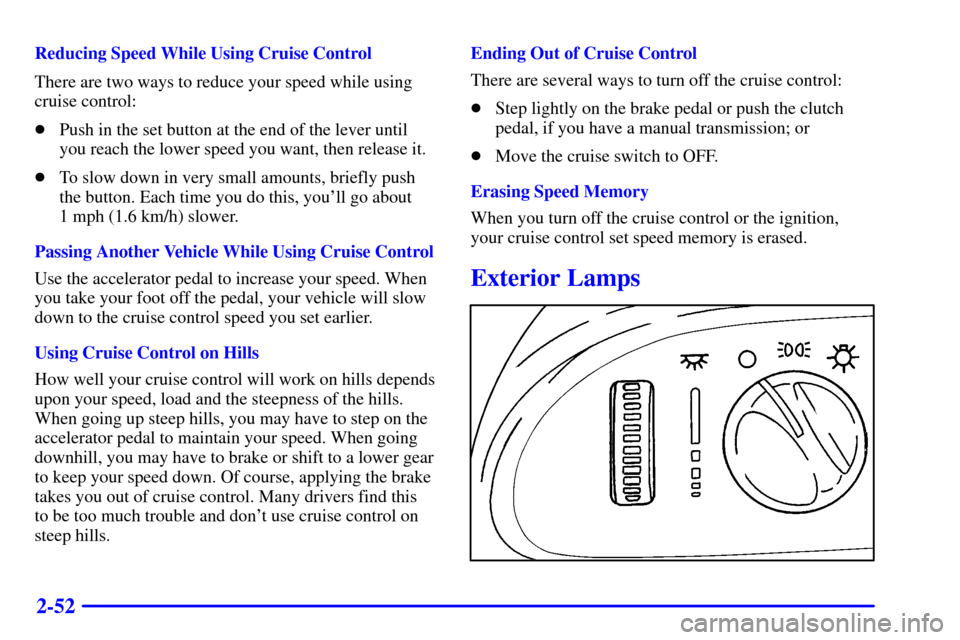Page 94 of 357

2-37 6-Speed
This is your shift pattern
for your six
-speed
manual transmission.
Here's how to operate your transmission:
FIRST (1): Push the clutch pedal and shift into
FIRST (1). Then, slowly let up on the clutch pedal
as you press the accelerator pedal.
You can shift into FIRST (1) when you're going less
than 20 mph (30 km/h). If you've come to a complete
stop and it's hard to shift into FIRST (1), put the shift
lever in NEUTRAL and let up on the clutch. Press the
clutch pedal back down. Then shift into FIRST (1).
SECOND (2): Press the clutch pedal as you let up
on the accelerator pedal and shift into SECOND (2).
Then, slowly let up on the clutch pedal as you press
the accelerator pedal.THIRD (3), FOURTH (4), FIFTH (5) and
SIXTH (6): Shift into THIRD (3), FOURTH (4),
FIFTH (5) and SIXTH (6) gear the same way you do
for SECOND (2). Slowly let up on the clutch pedal as
you press the accelerator pedal.
To stop, let up on the accelerator pedal and press the
brake pedal. Just before the vehicle stops, press the
clutch pedal and brake pedal, and shift to NEUTRAL.
NEUTRAL: Use this position when you start or idle
your engine.
REVERSE (R): To back up, push down the clutch
pedal and shift into REVERSE (R). Let up on the clutch
pedal slowly while pressing the accelerator pedal. If you
shift from SIXTH (6) into REVERSE (R), the shift lever
must be first placed in the NEUTRAL position centered
between SECOND (2) and THIRD (3) prior to shifting
into REVERSE (R).
Your six
-speed manual transmission has a feature that
allows you to safely shift into REVERSE (R) while the
vehicle is rolling at less than 5 mph (8 km/h).
If you have turned your ignition off and want to
park your vehicle in REVERSE (R), you will have to
move the shift lever quickly to the right, then forward
into gear.
Page 96 of 357
2-39
This light helps you to get the best possible fuel economy.
It will come on under these conditions:
�The engine coolant temperature is greater than
170�F (77�C),
�You are going 15 to 20 mph (24 to 32 km/h) and
�You are at 35 percent throttle or less.
Follow the shift speeds listed below when the SKIP
SHIFT light is on.
Computer
-Aided Manual Transmission Shift Speeds
�1st to 4th @ 15 mph (24 km/h)
�4th to 5th @ 25 mph (40 km/h)*
�5th to 6th @ 49 mph (64 km/h)**
Each time you come to a stop, the engine's Powertrain
Control Module (PCM) determines when to activate the
SKIP SHIFT upshift system. The SKIP SHIFT upshift
system is bypassed when you accelerate very quickly
from a stop.
*30 mph (48 km/h) when accelerating to highway speeds.
**45 mph (72 km/h) when accelerating to highway speeds.
Parking Brake
To set the parking brake, hold the brake pedal down and
pull up on the parking brake lever. If the ignition is on,
the brake system warning light will come on.
Page 98 of 357
2-41
Shifting Into PARK (P)
(Automatic Transmission Only)
CAUTION:
It can be dangerous to get out of your vehicle if
the shift lever is not fully in PARK (P) with the
parking brake firmly set. Your vehicle can roll.
If you have left the engine running, the vehicle
can move suddenly. You or others could be
injured. To be sure your vehicle won't move,
even when you're on fairly level ground, use
the steps that follow. If you're pulling a trailer,
see ªTowing a Trailerº in the Index.
1. Hold the brake pedal down with your right foot and
set the parking brake.
2. Move the shift lever into PARK (P) by holding in the
button on the lever and pushing the lever all the way
toward the front of your vehicle.
3. Turn the ignition key to LOCK.
4. Remove the key and take it with you. If you can
leave your vehicle with the key in your hand, your
vehicle is in PARK (P).
Page 99 of 357

2-42 Leaving Your Vehicle With the Engine
Running (Automatic Transmission Only)
CAUTION:
It can be dangerous to leave your vehicle with
the engine running. Your vehicle could move
suddenly if the shift lever is not fully in PARK (P)
with the parking brake firmly set. And, if you
leave the vehicle with the engine running, it could
overheat and even catch fire. You or others could
be injured. Don't leave your vehicle with the
engine running unless you have to.
If you have to leave your vehicle with the engine
running, be sure your vehicle is in PARK (P) and your
parking brake is firmly set before you leave it. After
you've moved the shift lever into PARK (P), hold the
regular brake pedal down. See if you can move the
shift lever away from PARK (P) without first pulling it
toward you. If you can, it means that the shift lever
wasn't fully locked into PARK (P).
Torque Lock (Automatic Transmission)
If you are parking on a hill and you don't shift your
transmission into PARK (P) properly, the weight of the
vehicle may put too much force on the parking pawl in
the transmission. You may find it difficult to pull the
shift lever out of PARK (P). This is called ªtorque lock.º
To prevent torque lock, set the parking brake and then
shift into PARK (P) properly before you leave the
driver's seat. To find out how, see ªShifting Into
PARK (P)º in the Index.
When you are ready to drive, move the shift lever out
of PARK (P) before you release the parking brake.
If torque lock does occur, you may need to have another
vehicle push yours a little uphill to take some of the
pressure from the parking pawl in the transmission,
so you can pull the shift lever out of PARK (P).
Shifting Out of PARK (P)
(Automatic Transmission)
Your vehicle has an automatic transmission shift lock
control system. You have to fully apply your regular
brake before you can shift from PARK (P) when the
ignition is in RUN. See ªAutomatic Transmission
Operationº in the Index.
Page 100 of 357

2-43
If you cannot shift out of PARK (P), ease pressure on
the shift lever
-- push the shift lever all the way into
PARK (P) and release the shift lever button as you
maintain brake application. Then press the shift lever
button and move the shift lever into the gear you wish.
If you ever hold the brake pedal down but still can't
shift out of PARK (P), try this:
1. Turn the ignition key to the OFF position.
2. Apply and hold the brake until the end of Step 4.
3. Shift to NEUTRAL (N).
4. Start the engine and then shift to the drive gear
you want.
5. Have the vehicle fixed as soon as you can.
Parking Your Vehicle
(Manual Transmission)
Before you get out of your vehicle, put your manual
transmission in REVERSE (R) and firmly apply the
parking brake.
If your vehicle is equipped to tow a trailer, see
ªTowing a Trailerº in the Index.
Parking Over Things That Burn
CAUTION:
Things that can burn could touch hot exhaust
parts under your vehicle and ignite. Don't park
over papers, leaves, dry grass or other things that
can burn.
Page 103 of 357

2-46 Power Windows (If Equipped)
Switches on the driver's door control each window when
the ignition is on or when RAP is active. (See ªRetained
Accessory Powerº in the Index.)The switch for the driver's window has an express
-down
feature. This switch is labeled AUTO. Quickly press and
release the bottom of the switch for the driver's window
and the window will lower completely. You can also
open the driver's window any amount by pressing the
switch again while the window is in the express
-down
mode when it has lowered to the position you want.
To stop the window while it is lowering, press the front
of the switch. To raise the window, press and hold the
front of the switch.
You can open the passenger's window any amount by
pressing the switch and releasing it when the window
has lowered to the position you want.
Horn
To sound the horn, press either horn symbol on your
steering wheel.
If your horn sounds two or three chirps when unlocking
your vehicle with the remote keyless entry transmitter
(if equipped), the alarm was triggered while you were
away. Check the vehicle before entering.
Page 109 of 357

2-52
Reducing Speed While Using Cruise Control
There are two ways to reduce your speed while using
cruise control:
�Push in the set button at the end of the lever until
you reach the lower speed you want, then release it.
�To slow down in very small amounts, briefly push
the button. Each time you do this, you'll go about
1 mph (1.6 km/h) slower.
Passing Another Vehicle While Using Cruise Control
Use the accelerator pedal to increase your speed. When
you take your foot off the pedal, your vehicle will slow
down to the cruise control speed you set earlier.
Using Cruise Control on Hills
How well your cruise control will work on hills depends
upon your speed, load and the steepness of the hills.
When going up steep hills, you may have to step on the
accelerator pedal to maintain your speed. When going
downhill, you may have to brake or shift to a lower gear
to keep your speed down. Of course, applying the brake
takes you out of cruise control. Many drivers find this
to be too much trouble and don't use cruise control on
steep hills.Ending Out of Cruise Control
There are several ways to turn off the cruise control:
�Step lightly on the brake pedal or push the clutch
pedal, if you have a manual transmission; or
�Move the cruise switch to OFF.
Erasing Speed Memory
When you turn off the cruise control or the ignition,
your cruise control set speed memory is erased.
Exterior Lamps
Page 110 of 357

2-53
The main lamp control is a knob that works these lamps:
�Headlamps
�Taillamps
�Parking Lamps
�License Lamps
�Sidemarker Lamps
�Instrument Panel Lights
Turn the knob to this position to turn on your
parking lamps and other operating lamps and lights
without your headlamps.
Turn the knob to this position to turn on your
headlamps and other operating lamps and lights.
Turn the knob to this position to turn off all the
lamps and lights.
Headlamps on Reminder
If you turn the ignition to OFF and leave the lamps on,
you will hear a chime, lasting up to five seconds. If the
lamps are still on when you open the driver's door, the
chime will sound again.
Daytime Running Lamps / Automatic
Headlamp Control (If Equipped)
Daytime Running Lamps (DRL) can make it easier for
others to see the front of your vehicle during the day.
DRL can be helpful in many different driving conditions,
but they can be especially helpful in the short periods
after dawn and before sunset.
A light sensor on top of the instrument panel automatically
turns the headlamps on, so be sure it isn't covered.
The DRL will not activate if the parking brake is engaged
prior to turning the ignition on.
The DRL system will make your front turn signal lamps
come on when:
�The ignition is on,
�the headlamp switch is off,
�the parking brake is released, and
�it is bright enough outside.
When the DRL are on, only your front turn signal lamps
will be on. The taillamps, sidemarker and other lamps
won't be on. Your instrument panel won't be lit up
either. When you use your turn signals, the front turn
signal and the taillamp of the desired side will flash.